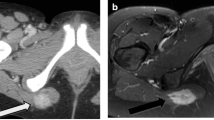Abstract
Background
Low-grade osteosarcoma, including low-grade central osteosarcoma and parosteal osteosarcoma, is an extremely rare variant, and the diagnosis is occasionally difficult. In this article we present cases of low-grade osteosarcomas that should be reviewed by a clinical oncologist.
Patients and methods
Nine cases of histologically diagnosed Broder grade 1 osteosarcoma were retrospectively reviewed. The pathological diagnoses included parosteal osteosarcoma, low-grade central osteosarcoma, and low-grade chondroblastic osteosarcoma in four, four, and one cases, respectively.
Results
Duration from initial surgical intervention including biopsy to final diagnosis as low-grade osteosarcoma was a mean of 9.4 months. The initial benign diagnoses on biopsy specimens included fibrous dysplasia in three cases, chondroblastoma in one case, and a giant cell tumor in one case. The average number of histological examinations was 1.8. Low-grade osteosarcomas are well suited for biological reconstruction: seven cases were reconstructed by frozen autografts, distraction osteogenesis, or vascularized bone grafts.
Conclusion
Low-grade osteosarcomas can be misdiagnosed as benign lesions, especially fibrous dysplasia. If the diagnosis of a low-grade osteosarcoma is not established on the basis of radiologic findings, care should be exercised, even when a biopsy suggests a benign lesion. Low-grade osteosarcomas should be treated with wide excision, even after an intralesional excision. Biological reconstruction might be a better option for low-grade osteosarcomas.




Similar content being viewed by others
References
Harkess JW (1964) Parosteal osteosarcoma. Am Surg 30:730–736
Unni KK, Dahlin DC, McLeod RA et al (1977) Intraosseous well-differentiated osteosarcoma. Cancer (Phila) 40(3):1337–1347
Song WS, Jeon DG, Kong CB et al (2011) Outcome of re-excision for intralesionally treated parosteal osteosarcoma. J Surg Oncol 103(3):264–268
Choong PF, Pritchard DJ, Rock MG et al (1996) Low grade central osteogenic sarcoma. A long-term followup of 20 patients. Clin Orthop Relat Res 322:198–206
Hayashi K, Tsuchiya H, Yamamoto N et al (2008) Functional outcome in patients with osteosarcoma around the knee joint treated by minimised surgery. Int Orthop 32(1):63–68
Tsuchiya H, Tomita K, Minematsu K et al (1997) Limb salvage using distraction osteogenesis. A classification of the technique. J Bone Jt Surg [Br] 79(3):403–411
Tsuchiya H, Nishida H, Srisawat P et al (2010) Pedicle frozen autograft reconstruction in malignant bone tumors. J Orthop Sci 15(3):340–349
Inwards CY, Unni KK (1995) Classification and grading of bone sarcomas. Hematol Oncol Clin N Am 9(3):545–569
Enneking WF, Dunham W, Gebhardt MC et al (1993) A system for the functional evaluation of reconstructive procedures after surgical treatment of tumors of the musculoskeletal system. Clin Orthop Relat Res 286:241–246
Mankin HJ, Lange TA, Spanier SS (1982) The hazards of biopsy in patients with malignant primary bone and soft-tissue tumors. J Bone Jt Surg [Am] 64(8):1121–1127
Dujardin F, Binh MB, Bouvier C et al (2011) MDM2 and CDK4 immunohistochemistry is a valuable tool in the differential diagnosis of low-grade osteosarcomas and other primary fibro-osseous lesions of the bone. Mod Pathol 24(5):624–637
Okada K, Nishida J, Morita T et al (2000) Low-grade intraosseous osteosarcoma in northern Japan: advantage of AgNOR and MIB-1 staining in differential diagnosis. Hum Pathol 31(6):633–639
Ragazzini P, Gamberi G, Benassi MS et al (1999) Analysis of SAS gene and CDK4 and MDM2 proteins in low-grade osteosarcoma. Cancer Detect Prev 23(2):129–136
Yoshida A, Ushiku T, Motoi T et al (2010) Immunohistochemical analysis of MDM2 and CDK4 distinguishes low-grade osteosarcoma from benign mimics. Mod Pathol 23(9):1279–1288
Kimura H, Dobashi Y, Nojima T et al (2013) Utility of fluorescence in situ hybridization to detect MDM2 amplification in liposarcomas and their morphological mimics. Int J Clin Exp Pathol 6(7):1223–1229
Tsuchiya H, Abdel-Wanis ME, Sakurakichi K et al (2002) Osteosarcoma around the knee. Intraepiphyseal excision and biological reconstruction with distraction osteogenesis. J Bone Jt Surg [Br] 84(8):1162–1166
Yamamoto N, Tsuchiya H, Tomita K (2003) Effects of liquid nitrogen treatment on the proliferation of osteosarcoma and the biomechanical properties of normal bone. J Orthop Sci 8(3):374–380
Conflict of interest
The authors declare no conflicts of interest.
Author information
Authors and Affiliations
Corresponding author
About this article
Cite this article
Hayashi, K., Tsuchiya, H., Yamamoto, N. et al. Diagnosis and treatment of low-grade osteosarcoma: experience with nine cases. Int J Clin Oncol 19, 731–738 (2014). https://doi.org/10.1007/s10147-013-0592-z
Received:
Accepted:
Published:
Issue Date:
DOI: https://doi.org/10.1007/s10147-013-0592-z




